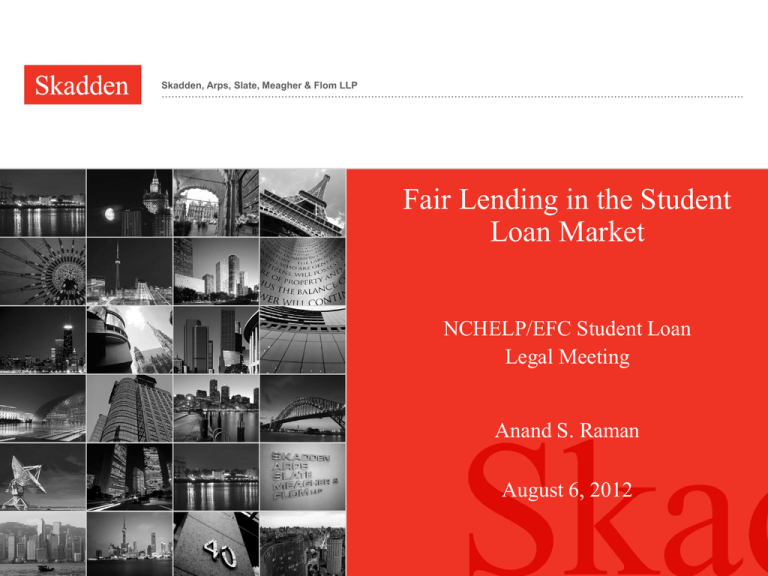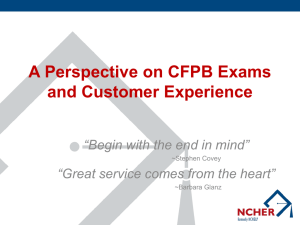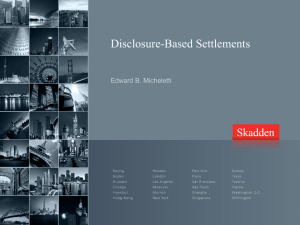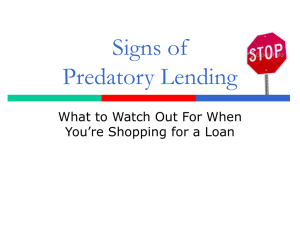
Skadden, Arps, Slate, Meagher & Flom LLP
Fair Lending in the Student
Loan Market
NCHELP/EFC Student Loan
Legal Meeting
Anand S. Raman
August 6, 2012
Overview
•
•
•
•
•
•
Fair lending laws
Types of lending discrimination
Cohort default rate
CFPB focus on student loans and fair lending
Fair lending statistical analysis
Other fair lending-related compliance issues
– Steering
– Servicemembers Civil Relief Act
•
Best practices
• Hypotheticals
Fair Lending in the Student Loan Market
|2
Skadden, Arps, Slate, Meagher & Flom LLP
Fair Lending Laws
Fair Lending in the Student Loan Market
|3
Skadden, Arps, Slate, Meagher & Flom LLP
Equal Credit Opportunity Act
•
The primary federal fair lending law is the Equal
Credit Opportunity Act (ECOA), 15 U.S.C. § 1691 et
seq.
• ECOA prohibits discrimination against any applicant
on the basis of race, color, religion, national origin,
sex or marital status, or age (provided the applicant
has the capacity to contract), because all or part of the
applicant’s income derives from any public assistance
program, or because the applicant has in good faith
exercised any right under certain laws
Fair Lending in the Student Loan Market
|4
Skadden, Arps, Slate, Meagher & Flom LLP
Scope of ECOA
Prohibits discrimination with respect to “any aspect of
a credit transaction”
• Limited to discrimination against “applicants,” and
thus, has limited applicability to pre-application
marketing
•
– ECOA’s implementing regulation – Regulation B, 12 C.F.R.
Part 1002 – also prohibits “discouragement” of potential
applicants on a prohibited basis
Fair Lending in the Student Loan Market
|5
Skadden, Arps, Slate, Meagher & Flom LLP
ECOA Enforcement
•
ECOA is enforced primarily by the Consumer
Financial Protection Bureau
• Other agencies with enforcement authority include the
prudential bank regulators (OCC, FDIC, and Federal
Reserve), the Department of Justice, and the FTC
• Private plaintiffs can sue for actual and punitive
damages in individual and class actions
Fair Lending in the Student Loan Market
|6
Skadden, Arps, Slate, Meagher & Flom LLP
Other Fair Lending Laws
The Civil Rights Act of 1866, 42 U.S.C. §§ 1981,
1982, prohibits intentional discrimination on the basis
of race
• States and localities have anti-discrimination laws that
may be applicable
•
– Some of these laws contain prohibited bases in addition to
those under ECOA, such as sexual orientation or gender
identity and military status
Fair Lending in the Student Loan Market
|7
Skadden, Arps, Slate, Meagher & Flom LLP
Types of Lending
Discrimination
Fair Lending in the Student Loan Market
|8
Skadden, Arps, Slate, Meagher & Flom LLP
Theories of Fair Lending Liability
•
Fair lending lawsuits are generally brought under
three different theories of liability:
– Overt discrimination
– Disparate treatment
– Disparate impact
Fair Lending in the Student Loan Market
|9
Skadden, Arps, Slate, Meagher & Flom LLP
Overt Discrimination
Overt discrimination is where a lender’s policies or
practices openly discriminate against a protected class
in a manner that is not authorized by law
• Examples
•
– Limiting a loan program to individuals 65 or younger
– Setting different rates for spousal co-applicant borrowers
and non-spousal co-applicant borrowers
– A loan officer informs an applicant that he does not like to
originate student loans to members of a particular ethnic
group because their credit is weak
Fair Lending in the Student Loan Market
| 10
Skadden, Arps, Slate, Meagher & Flom LLP
Disparate Treatment
•
•
•
•
•
Disparate treatment is where a lender treats members of a
protected class differently than non-protected class members
Discriminatory intent must be shown
Often premised on statistical analyses indicating that members
of a protected class are harmed in some way as compared to
similarly situated, non-protected class members
Usually validated through review of individual files
Redlining – declining to do business in an area on account of
the racial or ethnic composition of that area – is a type of
disparate treatment
Fair Lending in the Student Loan Market
| 11
Skadden, Arps, Slate, Meagher & Flom LLP
Disparate Impact
•
Disparate impact liability may occur when
– a specific, facially neutral practice has an adverse effect on
a prohibited basis
– that cannot be justified with a legitimate business purpose,
or
– where the business purpose can be achieved as well with a
less discriminatory alternative
Fair Lending in the Student Loan Market
| 12
Skadden, Arps, Slate, Meagher & Flom LLP
Disparate Impact
•
•
•
Disparate impact has been relied upon frequently in
government fair lending enforcement and class action litigation
Last year, the Supreme Court agreed to hear a case to decide
whether disparate impact can apply under the Fair Housing
Act. The appeal, however, was dropped, and there is therefore
some uncertainty as to the viability of disparate impact under
the fair lending laws.
Regulators are continuing to indicate that they will bring cases
under this theory
Fair Lending in the Student Loan Market
| 13
Skadden, Arps, Slate, Meagher & Flom LLP
Types of Lending Discrimination
•
•
•
•
•
•
Underwriting discrimination
Redlining / reverse redlining
Pricing discrimination
“Steering” towards a product type or lending channel
Different levels of assistance
Loan servicing discrimination
– Fees and waivers
– Loan modifications and other loss mitigation
Fair Lending in the Student Loan Market
| 14
Skadden, Arps, Slate, Meagher & Flom LLP
Cohort Default Rate
Fair Lending in the Student Loan Market
| 15
Skadden, Arps, Slate, Meagher & Flom LLP
Cohort Default Rate
•
•
•
•
Historically, a key fair lending concern for student lending has
been use of a school’s “cohort default rate”
The cohort default rate is a measure of the federal student loan
repayment history of a particular group or “cohort” of
borrowers, which is available at the school level
Lenders have used a school’s cohort default rate for
underwriting and pricing decisions
It has been alleged that use of cohort default rate in the lending
process has led to a disparate impact against minority students
Fair Lending in the Student Loan Market
| 16
Skadden, Arps, Slate, Meagher & Flom LLP
Rodriguez et al. v. Sallie Mae (D. Conn.)
•
Class action on behalf of minority student loan borrowers
alleging pricing discrimination and steering to subprime private
student loans in violation of ECOA, plus other violations
• Challenged use of underwriting and pricing criteria, including
college attended, student’s credit history, and credit history of
cosigner
• In October 2011, court approved settlement on behalf of Black,
Hispanic, and Native American borrowers from 2003 to 2011
– $500,000 for scholarships and credit education
– $1.8 million in attorneys’ fees and expenses
– Enhanced disclosures regarding school choice / cohort default rate
affecting loan terms
Fair Lending in the Student Loan Market
| 17
Skadden, Arps, Slate, Meagher & Flom LLP
CFPB Findings on Cohort Default Rate
•
•
The CFPB’s Report on Private Student Loans, released July 20,
2012 (the “Report”) found that some student lenders use Cohort
Default Rate in custom scorecards used for underwriting and
pricing decisions
“[R]acial and ethnic minority students are disproportionately
concentrated in schools with higher CDRs. Accordingly, use of
CDR to determine loan eligibility, underwriting, and pricing
may have a disparate impact on minority students by reducing
their access to credit and requiring those minority students who
meet the lenders’ eligibility thresholds to pay higher rates than
are otherwise available to similarly creditworthy non-Hispanic
White students at schools with lower CDRs.” Report, p. 80.
Fair Lending in the Student Loan Market
| 18
Skadden, Arps, Slate, Meagher & Flom LLP
CFPB CDR Analysis
Fair Lending in the Student Loan Market
| 19
Skadden, Arps, Slate, Meagher & Flom LLP
CFPB Focus On Student
Loans And Fair Lending
Fair Lending in the Student Loan Market
| 20
Skadden, Arps, Slate, Meagher & Flom LLP
CFPB Focus on Student Loan Fair Lending
“Today we are giving fair notice on fair lending. We are letting
both lenders and consumers know that in our examination and
enforcement work, we will combat unlawful, discriminatory
practices—including those that have an illegal disparate impact
on protected borrowers. We will look not only at mortgage
lending, but also at other types of credit including student loans,
loans for cars, and credit cards.”
Patrice Ficklin, CFPB Assistant Director for Fair Lending and Equal
Opportunity, “Fair Notice on Fair Lending” (Apr. 18, 2012)
Fair Lending in the Student Loan Market
| 21
Skadden, Arps, Slate, Meagher & Flom LLP
CFPB Fair Lending Authority for Student Lending
•
The CFPB has fair lending enforcement authority over
student lenders
• The CFPB has authority to supervise all nondepository private student lenders, as well as all banks
with more than $10 billion in assets
– The CFPB’s non-depository examination program
commenced in January 2012, with the appointment of CFPB
Director Richard Cordray
Fair Lending in the Student Loan Market
| 22
Skadden, Arps, Slate, Meagher & Flom LLP
CFPB Student Lending Activity
•
•
•
CFPB worked with the Department of Education to release a
financial aid “shopping sheet” designed to help students and
parents better compare the costs of different colleges and
understand their payment options
Section 1035 of the Dodd-Frank Act established the Office of
Private Education Loan Ombudsman in the CFPB
CFPB has released several Q&As relating to private student
lending on its “Ask CFPB” website
– Most of the questions focus on collections and default
Fair Lending in the Student Loan Market
| 23
Skadden, Arps, Slate, Meagher & Flom LLP
Student Lending Complaint Portal
•
•
•
•
•
The CFPB has established a complaint portal dedicated to student lending
complaints
The portal includes a discrimination question
Complaints could prompt CFPB student lending fair lending inquiries
The CFPB has stated that it will focus primarily on complaints where the
consumer disputed the response or where companies failed to respond
within 15 days
Some data from the complaint portal is likely to be released publicly,
including the identity of the lender
Fair Lending in the Student Loan Market
| 24
Skadden, Arps, Slate, Meagher & Flom LLP
Private Student Lending Report
•
Section 1077 of the Dodd-Frank Act required the
CFPB and the U.S. Department of Education to
prepare a report on the private student lending market
• The Dodd-Frank Act required the Report to address
fair lending and borrower characteristics
• The Report was issued on July 20, 2012
Fair Lending in the Student Loan Market
| 25
Skadden, Arps, Slate, Meagher & Flom LLP
The Report’s Fair Lending Findings
•
•
As discussed above, the Report found that some private student
lenders use Cohort Default Rate for pricing and underwriting
and that this may raise disparate impact fair lending concerns
The Report suggested consideration of compiling additional
data regarding student lending underwriting outcomes, similar
to the Home Mortgage Disclosure Act
– “Additional outcome data might also give the public and federal
regulators greater confidence that underwriting is in compliance with the
nation’s fair lending laws.” Report, p. 88.
Fair Lending in the Student Loan Market
| 26
Skadden, Arps, Slate, Meagher & Flom LLP
The Report’s Demographics Findings
•
The Report provided information on the age, sex, and race of
private student loan borrowers
• Race
– In the 2007-2008 academic year (the most recent data described), the
frequency of exclusive use of private student loans does not vary by
racial group
– A higher percentage of African-American borrowers use a combination
of federal and private student loans than all other racial groups
•
Sex
– There is a small but statistically significant higher proportion of women
(11%) who have a combination of private and non-private student loans
than men (10%)
– There is no statistically significant difference for the percentage of men
and women who have only private student loans
Fair Lending in the Student Loan Market
| 27
Skadden, Arps, Slate, Meagher & Flom LLP
CFPB Data Analysis
Fair Lending in the Student Loan Market
| 28
Skadden, Arps, Slate, Meagher & Flom LLP
DOJ Student Lending Enforcement
•
As noted above, the Department of Justice may also
enforce ECOA against student lenders
• “The [Department of Justice Civil Rights] Division
also will focus on the challenges in the current market,
including . . . discrimination in student lending”
DOJ Civil Rights Division Report to Congress (Mar. 2012)
•
The DOJ announced in March 2012 that it has one
pending student loan pricing fair lending
investigation, which was referred by the FDIC
Fair Lending in the Student Loan Market
| 29
Skadden, Arps, Slate, Meagher & Flom LLP
Fair Lending Statistical
Analysis
Fair Lending in the Student Loan Market
| 30
Skadden, Arps, Slate, Meagher & Flom LLP
Statistical Analyses That Can be Performed
•
Underwriting
– Denial disparities
– Exceptions / overrides
•
Pricing analysis
– APR
– Discretionary pricing
•
Redlining / market penetration
• Loss mitigation
Fair Lending in the Student Loan Market
| 31
Skadden, Arps, Slate, Meagher & Flom LLP
Statistical Analysis Issues
•
•
•
•
•
Credit controls to identify “similarly situated”
borrowers
Controls for market
Controls for lender underwriting centers or by channel
or branch
Statistical significance
Conducting analyses under privilege
Fair Lending in the Student Loan Market
| 32
Skadden, Arps, Slate, Meagher & Flom LLP
Data issues
•
With student lending, race, ethnicity, and sex data on
applicants may not be collected
– As noted above, the CFPB’s Report on Private Student
Lending recommended enhanced data gathering on student
lending
•
Proxies must be used to assign protected class status
to loans for statistical analysis
– Geographic proxies for race
• As the Report noted, a student’s use of a temporary or dormitory
addresses on loan applications could complicate use of geography as
a proxy for race in a student loan analysis
– Name proxies for sex and ethnicity
Fair Lending in the Student Loan Market
| 33
Skadden, Arps, Slate, Meagher & Flom LLP
Other Compliance Issues
Fair Lending in the Student Loan Market
| 34
Skadden, Arps, Slate, Meagher & Flom LLP
Steering
•
In its July 20 report, the CFPB raised concerns with
borrowers obtaining high-rate private student loans
(“PSL”) before applying for Stafford loans or
exhausting Stafford limits
• According to the report, 10.9% of PSL borrowers
apply for aid but do not take up Stafford loans.
Similarly, approximately 40% of PSL borrowers with
Stafford loans do not borrow the Stafford maximum
Fair Lending in the Student Loan Market
| 35
Skadden, Arps, Slate, Meagher & Flom LLP
Steering
The CFPB has stated that PSLs are “rarely an
economical choice” relative to Stafford loans
• Lenders may be subject to increased “steering”
scrutiny from regulators based on how they originate
PSLs
• Regulators may focus on fair lending issues (i.e.,
whether prohibited basis group applicants were
disproportionately steered to PSLs) or
deception/unfairness in how PSLs and Stafford loans
are promoted
•
Fair Lending in the Student Loan Market
| 36
Skadden, Arps, Slate, Meagher & Flom LLP
SCRA
•
The Servicemembers Civil Relief Act (SCRA)
provides civil protections and rights to
servicemembers
• Among the protections is a 6% cap on pre-service
debts and restrictions on default judgments against
members in active duty military service
Fair Lending in the Student Loan Market
| 37
Skadden, Arps, Slate, Meagher & Flom LLP
SCRA
•
The DOJ has recently pursued SCRA claims against
lenders through the DOJ Civil Rights Division,
although there have been no DOJ-SCRA enforcement
actions to date relating to student lending.
• A large lender recently agreed to pay $2.3 million to
settle a private SCRA suit
– Servicemembers had alleged that they were charged more
than 6% interest on their student loans
Fair Lending in the Student Loan Market
| 38
Skadden, Arps, Slate, Meagher & Flom LLP
Best Practices
Fair Lending in the Student Loan Market
| 39
Skadden, Arps, Slate, Meagher & Flom LLP
Best Practices
•
Dedicated fair lending compliance personnel
• Policies and procedures
– Written fair lending compliance policies and procedures
– Lending policies and procedures should be reviewed for fair
lending compliance
•
Controls on exercise of discretion
– Caps on pricing and other discretion, with monitoring
– Written policies to guide exercise of discretion
– Documentation of rationale for discretionary decisions
Fair Lending in the Student Loan Market
| 40
Skadden, Arps, Slate, Meagher & Flom LLP
Best Practices
•
Fair lending training
• Complaint monitoring
– Fair lending complaints should be escalated
– Proactively review policies and products that lead to fair
lending complaints
•
New product review
• Marketing review
– Review of marketing collateral
– Solicitation criteria
Fair Lending in the Student Loan Market
| 41
Skadden, Arps, Slate, Meagher & Flom LLP
Best Practices
•
Fair lending self-assessment
• Internal audit
• Monitoring
– Statistical analysis
– File reviews
– Remediation based on results, if necessary
Fair Lending in the Student Loan Market
| 42
Skadden, Arps, Slate, Meagher & Flom LLP
HYPOTHETICALS
Fair Lending in the Student Loan Market
| 43
Skadden, Arps, Slate, Meagher & Flom LLP
Hypotheticals
Our advertisements feature only younger-looking
students. Is that problematic?
2. We require a co-signer for all of our private student
loans. Can that lead to a disparate impact?
3. Our pricing model looks at the age of the applicant.
I know that age is a prohibited basis factor, but are
there circumstances where it is legal to consider
age?
4. We use CDR as one of many factors in our model.
Does that mitigate the risk of using CDR?
1.
Fair Lending in the Student Loan Market
| 44
Skadden, Arps, Slate, Meagher & Flom LLP
For More Information Contact
Anand S. Raman
anand.raman@skadden.com
(202) 371-7019
Fair Lending in the Student Loan Market
| 45
Skadden, Arps, Slate, Meagher & Flom LLP










